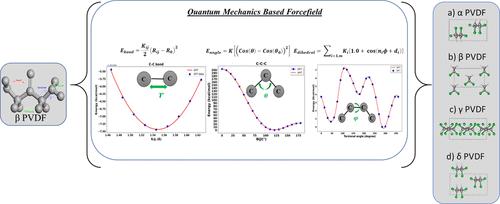基于量子力学的描述聚偏氟乙烯聚合物动力学和压电性能的新力场
IF 3.2
3区 化学
Q2 CHEMISTRY, PHYSICAL
引用次数: 0
摘要
聚偏氟乙烯(PVDF)复合材料由于其不同的压电、热释电和机械性能而成为许多应用领域的重要材料。为了使PVDF的研究及其修改作为传感器和致动器的新应用成为可能,我们开发了一个新的力场(PVDF- ff),可以准确地预测PVDF的四个实验表征相的弹性,介电和压电特性。PVDF-FF是通过将力场参数拟合到β晶体形式的量子力学结构和性质中而得到的,并且该方法对其他三个相也是准确的。该PVDF-FF基于UFF通用力场,这是整个元素周期表(Z = 103)的简单通用力。因此,它与PVDF与其他材料的结合是兼容的,例如,在多功能应用中,使用PVDF作为压电开关,传感器或执行器的设备。这种获得单一uff力场的方法能够描述PVDF的α, β, γ和δ相的结构能量,机械,介电和压电性能,这对于开发其他复杂的多功能材料是有用的。本文章由计算机程序翻译,如有差异,请以英文原文为准。

New Quantum Mechanics Based Force Field for Describing Dynamics and Piezoelectric Properties for Various Phases of Poly(vinylidene) Fluoride Polymer
Polyvinylidene fluoride (PVDF) composites have emerged as materials of great interest for many applications due to their diverse piezoelectric, pyroelectric, and mechanical properties. To enable studies on PVDF and its modifications for new applications as sensors and actuators, we developed a new force field (PVDF-FF) that accurately predicts the elastic, dielectric, and piezoelectric properties of the four experimentally characterized phases of PVDF. The PVDF-FF was derived by fitting the force field parameters to the quantum mechanics structure and properties of the beta crystal form in such a way that it was also accurate for the other three phases. This PVDF-FF is based on the UFF universal force field, which is a simple generic force for the entire periodic table (up to Z = 103). Thus, it is compatible with combining PVDF with other materials, for example, in multifunctional applications for devices using PVDF as a piezoelectric switch, sensor, or actuator. This approach for obtaining a single UFF-based force field capable of describing the structural energetic, mechanical, dielectric, and piezoelectric performance of the α, β, γ, and δ phases of PVDF should be useful for developing other complex multifunctional materials.
求助全文
通过发布文献求助,成功后即可免费获取论文全文。
去求助
来源期刊

The Journal of Physical Chemistry C
化学-材料科学:综合
CiteScore
6.50
自引率
8.10%
发文量
2047
审稿时长
1.8 months
期刊介绍:
The Journal of Physical Chemistry A/B/C is devoted to reporting new and original experimental and theoretical basic research of interest to physical chemists, biophysical chemists, and chemical physicists.
 求助内容:
求助内容: 应助结果提醒方式:
应助结果提醒方式:


